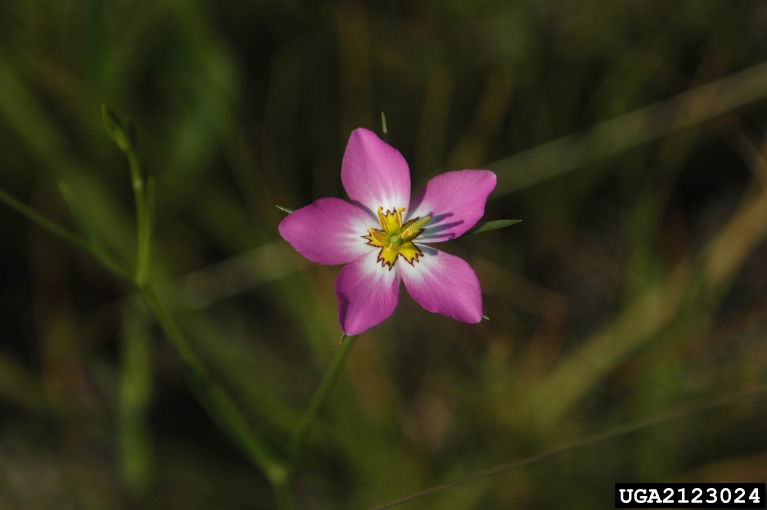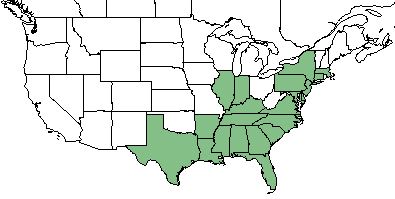Difference between revisions of "Sabatia campanulata"
(→Ecology) |
(→Ecology) |
||
| Line 36: | Line 36: | ||
<!--===Seed dispersal===--> | <!--===Seed dispersal===--> | ||
<!--===Seed bank and germination===--> | <!--===Seed bank and germination===--> | ||
| − | + | ||
| + | ===Fire ecology=== <!--Fire tolerance, fire dependence, adaptive fire responses--> | ||
| + | Populations of ''Sabatia campanulata'' have been known to persist through repeated annual burning.<ref>Platt, W.J., R. Carter, G. Nelson, W. Baker, S. Hermann, J. Kane, L. Anderson, M. Smith, K. Robertson. 2021. Unpublished species list of Wade Tract old-growth longleaf pine savanna, Thomasville, Georgia.</ref> | ||
<!--===Pollination and use by animals===--> | <!--===Pollination and use by animals===--> | ||
<!--==Diseases and parasites==--> | <!--==Diseases and parasites==--> | ||
Revision as of 02:05, 28 July 2021
Common name: slender marsh-pink[1], slender rose gentian[2]
| Sabatia campanulata | |
|---|---|

| |
| Photo by Chris Evans, University of Illinois, Bugwood.org, hosted at Forestryimages.org | |
| Scientific classification | |
| Kingdom: | Plantae |
| Division: | Magnoliophyta - Flowering plants |
| Class: | Magnoliopsida - Dicots |
| Order: | Gentianales |
| Family: | Gentianaceae |
| Genus: | Sabatia |
| Species: | S. campanulata |
| Binomial name | |
| Sabatia campanulata L. | |

| |
| Natural range of Sabatia campanulata from USDA NRCS Plants Database. | |
Contents
Taxonomic Notes
Synonyms: S. campanulata var. gracilis (Michaux) Fernald
Varieties: none
Description
S. campanulata is a perennial forb/herb of the Gentianaceae family native to North America.[2]
Distribution
S. campanulata is found along the southeastern coast of the United States from Texas to Massachusetts.[2]
Ecology
Habitat
S. campanulata proliferates in pine savannas, bogs, seeps, and fens.[1] Specimens have been collected from borders of brackish marshes, moist loam of longleaf pine woodland, mesic pine-oak woods, and cypress pond.[3]
Fire ecology
Populations of Sabatia campanulata have been known to persist through repeated annual burning.[4]
Conservation, cultivation, and restoration
S. campanulata is listed as endangered by the Department of Arkansas Heritage Inventory Research Program, the Kentucky State Nature Preserves Commission, the Maryland Department of Natural Resources Natural Heritage Program, the Massachusetts Division of Fisheries and Wildlife Natural Heritage and Endangered Species Program, and the New York Division of Land and Forests Department of Environmental Conservation, and is listed as extirpated by the Indiana Department of Natural Resources Division of Nature Preserves and the Pennsylvania Department of Conservation and Natural Resources.[2]
Cultural use
Photo Gallery
References and notes
- ↑ 1.0 1.1 Weakley, A. S. (2015). Flora of the Southern and Mid-Atlantic States. Chapel Hill, NC, University of North Carolina Herbarium.
- ↑ 2.0 2.1 2.2 2.3 USDA Plant Database https://plants.usda.gov/core/profile?symbol=SACA26
- ↑ URL: http://herbarium.bio.fsu.edu. Last accessed: June 2018. Collectors: R.K. Godfrey, Walter Lewsi, Loran Anderson, R.Kral, Albert Pittman, Kathy Boyle. States and counties: Florida (Calhoun, Jefferson, Gadsden, Liberty, Holmes, Franklin) Georgia (Thomas) South Carolina (Lee)
- ↑ Platt, W.J., R. Carter, G. Nelson, W. Baker, S. Hermann, J. Kane, L. Anderson, M. Smith, K. Robertson. 2021. Unpublished species list of Wade Tract old-growth longleaf pine savanna, Thomasville, Georgia.